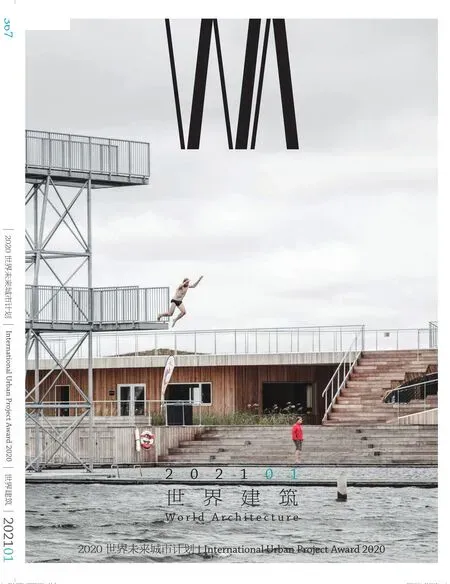艺仓美术馆及其长廊,上海,中国
建筑设计:大舍建筑设计事务所
艺仓美术馆的旧址是黄浦江浦东一侧的老白渡码头,也是个煤炭装卸码头。艺仓美术馆的设计工作一方面抢救了险些被拆除的工业遗构,另一方面也让一座美术馆出现在了本不可能出现的地方。
工业文明是上海城市发展自身现代性的重要部分。随着后工业时代的城市功能的更新,诸多已经从城市的生产活动中退场的工业建筑,作为上海城市发展史的重要部分,是拆除还是改造以及如何改造,是一个有意义的话题。在上海,有无数的工业建筑因为工厂的搬迁而成为临时的废墟,它们有的会保留,大多数则会被拆除,并在原址建设新楼,或者变为公共绿地。不过在黄浦江的两岸,随着2017年浦江两岸公共空间贯通计划的推进,人们已经意识到将更多工业建筑保留的空间及其文化价值。
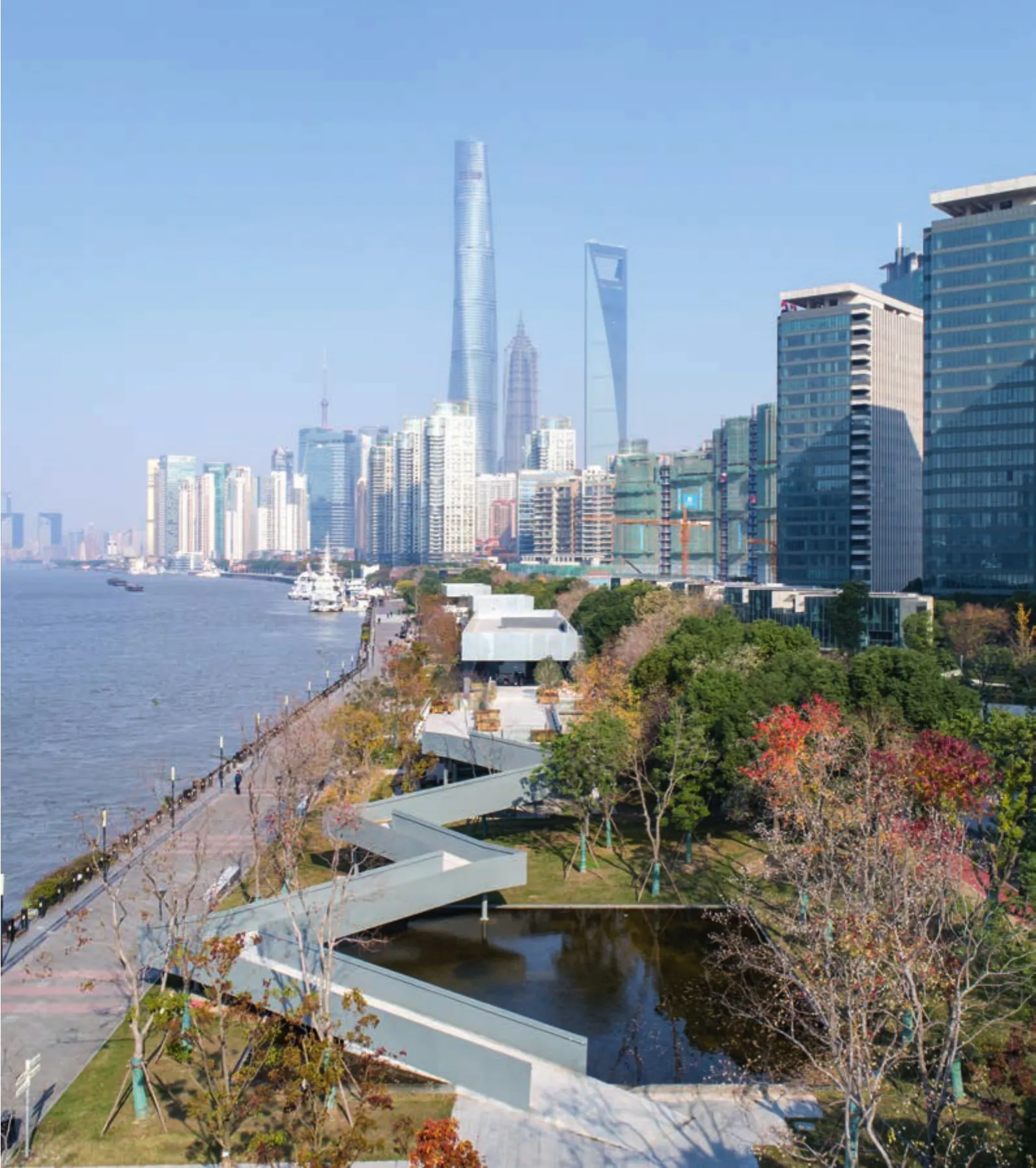
1 从美术馆望向长廊/View from the museum towards the walkway
老白渡煤仓改造于2015年前即已开始,当时面临过险些被拆除的命运。恰好在它被拆除的过程中,2015年第一届上海城市空间艺术季在这里安排了一个案例展的分展场,策展人冯路和柳亦春以工业建筑的改造与再利用作为主题,在原本被部分拆除的煤仓废墟中,借助于影像、声音和舞蹈,举办了一次题为“重新装载”的艺术与建筑相结合的空间展览,让人们能设身处地地意识到工业建筑的价值,以及将煤仓变身为公共文化空间的意义。煤仓的物业持有者及其未来美术馆的进驻方在这次废墟中的展览中看到了工业建筑粗砺的表面与展览空间相结合的可能性与既有空间的力量,欣然接受了基于保留主要煤仓空间及其结构的改造原则,不仅把原来的画廊升级为美术馆,更是直接将美术馆命名为“艺仓美术馆”。
然而升级后的艺仓美术馆对于展览空间面积的需求远大于现有煤仓的空间面积,为更好地组织空间,并尽可能减小对现有煤仓结构的破坏,设计采用了悬吊结构,利用已经被拆除屋顶后留下的顶层框架柱支撑一组巨型桁架,并层层下挂,在完成空间拓展和流线组织的同时也构建了原本封闭的仓储建筑所缺乏的与黄浦江景观之间的公共性连接。
建筑首层是有着8个煤仓漏斗天花的多功能大厅,旧有的结构直接暴露在室内,与室外精致的阳极氧化铝板的外立面形成了鲜明的对比。二层是低矮的由煤料斗的斜面间隔的多媒体展厅。三层是美术馆的主展厅,它利用原来储煤的8个方形煤斗,相互打通形成了独一无二的带着原本粗粝质感的混凝土墙体展厅。四层则又是一个高大空间的展览厅,原本斜向运煤的通道被改造为钢结构大楼梯可以由室外直达这一层,从而也为美术馆的多种运营和展览方式提供了多重的人行流线。
旧有结构并未暴露在外,而是深藏在看上去是一个崭新建筑的核心之中。
美术馆北侧的高架运煤廊道长约250m,改造前只留下一排排平行阵列的混凝土排架,间隔有一些垂直方向的横梁连接。作为老白渡景观绿地的一部分,整个煤仓和高架廊道在满足新的文化服务功能、构建新旧关系并置的同时,如何建立浦江贯通中一处重要的公共空间节点,是设计更为潜在的任务。高架的步道、步道下的玻璃体艺术与服务空间、上下的楼梯、从一方水池上蜿蜒而过的折形坡道、直上三层的钢桁架大楼梯、在大楼梯中途偏折的连接艺仓美术馆二层平台的天桥、美术馆在闭馆后仍能抵达并穿越的各层观景平台与咖啡吧、穿过美术馆后南侧的折返坡道与公共厕所,这些都在构建独特的属于老白渡这个工业煤炭渡口区域城市更新后的公共性与新的空间文化形象。它将公共美术馆的功能与原有的工业遗构有效结合,在满足美术馆内部功能的同时,又赋予公共空间以极大的自由度,这也为美术馆在新时期的运营带来新的可能性。
长廊的设计采用了张弦梁加悬吊钢结构系统,与表面已经有一定的风化腐蚀的混凝土排架结构相结合,形成了一个新的整体结构,但是又保持了各自的视觉完整性。它既承担了上部廊道的地面结构,也向下挂着玻璃盒体商店的屋顶部分,这既使商店的盒体建筑从构架中游离出来,又仍然是结构整体的一部分。这种做法并没有刻意去强调既有的结构体,而是使已然废墟般的结构再次融入新的建造,它使曾经的工业碎片悄然进入了上海的日常生活环境。
Shanghai Modern Art Museum is located on the former Laobaidu Wharf, as a previous coal-loading wharf, along the east side of the Huangpu River.The design, on the one hand, preserved the almost demolished industrial structures, while allowing a museum to occur where it could not have been possible.
Industrial civilisation acts as a vital part of Shanghai's own modernity development. With the renewal of urban functions in the post-industrial age, many industrial buildings are facing the destiny of being demolished or transformed in some way,which becomes a meaningful topic. In Shanghai,there are countless industrial buildings being temporary ruins due to the relocation of factories,some of them may be kept, but most will be replaced by a new building or public green space. However,with the promotion of the 2017 Open Space leading down Huangpu River programme, people on both sides of the Huangpu river have realised the space and culture value of retaining more industrial buildings.
The Laobaidu coal bunker transformation,which began before 2015, was faced with the fate of demolition. Fortunately, in 2015, the first session of Shanghai Urban Spatial Art Festival set here a case study sub-exhibition space which theme was set by its curators, FENG Lu and LIU Yichun as the transformation and reuse of industrial buildings.By using images, sounds and dancing art, they performed a space exhibition of the combination of art and architecture called "Reload" in the partly dismantled coal bunker ruins which evoked people's realisation of the value of industrial architecture and the meaning of turning the coal bunker into public culture space. Since then, the property owner of the coal bunker and its future gallery party sensed the possibility and strength of the combination of crude industrial architecture façade and exhibit space,willingly accepted the transformation principle of keeping the main space and structure of the bunker,and named it "Modern Art Gallery".
However, the spatial demand for exhibition in the gallery is much greater than that of existing coal bunker. To better organise the museum and minimise damage to the building, a large set of trusses have been suspended from the top frame columns, which remain after the roof was removed. Layering the trusses downward,the floor slabs were connected to the suspended hooks on one side and to the original structure of the coal bunker on the other side. It reintegrated the horizons of the Huangpu River landscape and gave a new sense of openness to the previously closed-off warehouse.
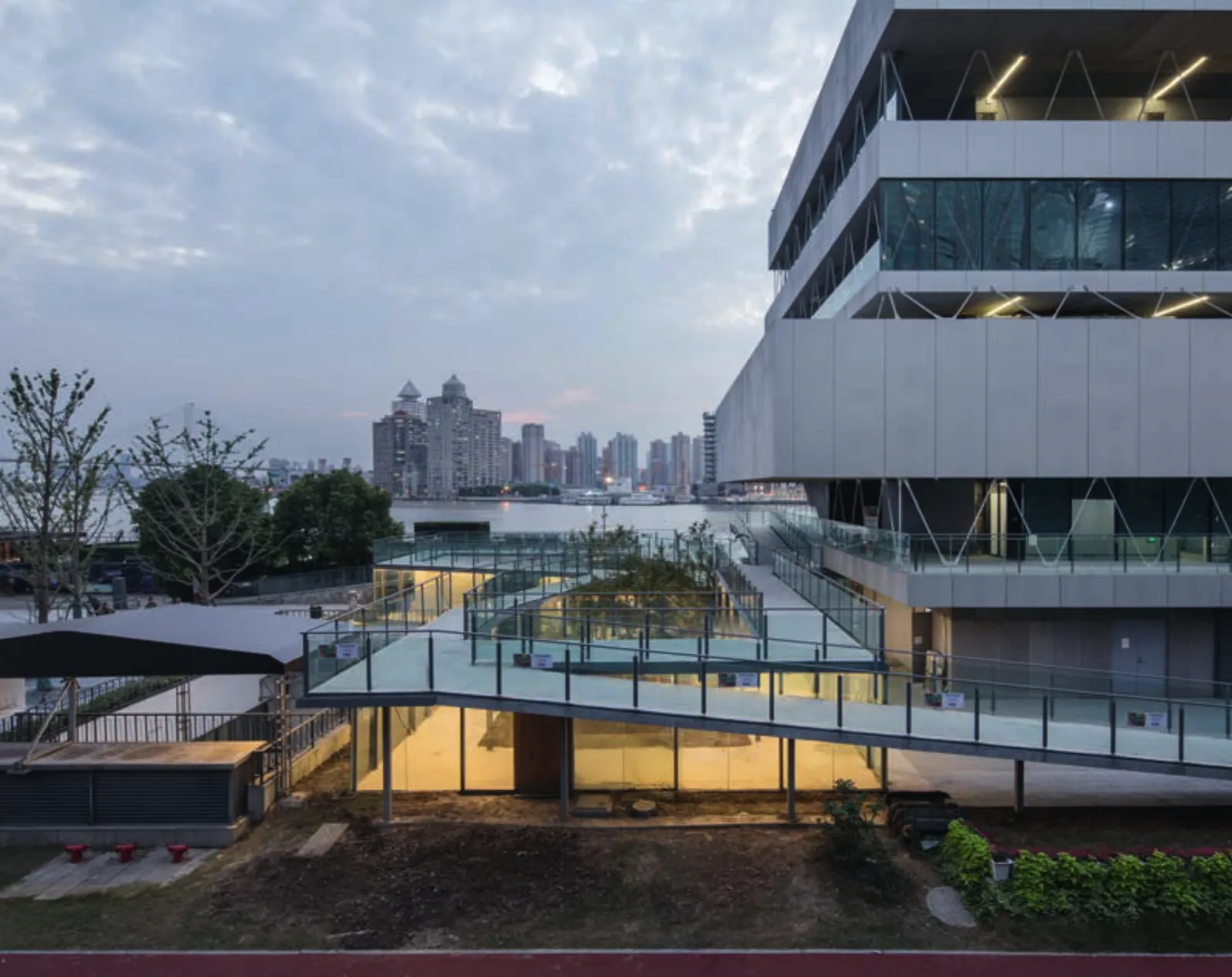
3 可穿越的公共空间/Permeable public space
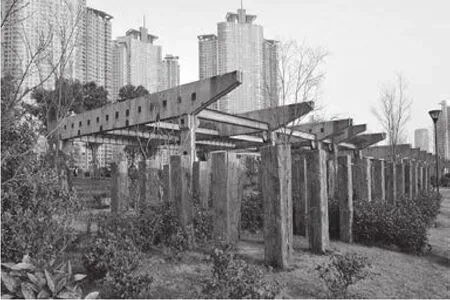
4 原有排架/Existing frame structures
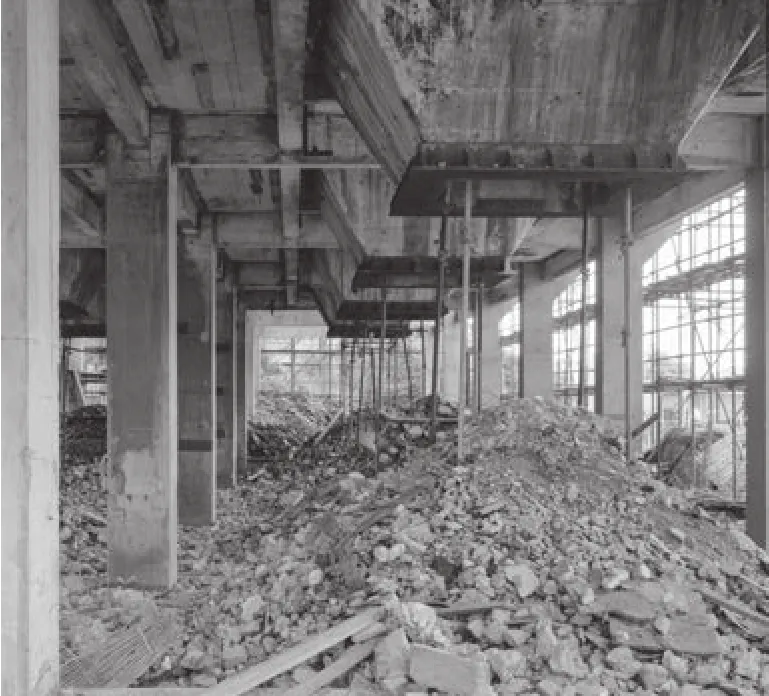
5 原有煤仓/Existing coal hoppers
On the ground level, there is a multi-functional hall where eight coal hoppers are exposed as ceiling. A Sharp contrast is made between the exposed old structure in the interior and the delicate exterior façade of anodised aluminum cladding. A multi-media exhibition hall sits on the second floor, which occupies the interval space in between the coal hoppers. On the third floor, the original walls separating the eight coal hoppers were removed in order to make a main exhibition hall, which is characterised with a unique quality of spatial roughness between concrete walls. On the fourth floor, there is another full-height exhibition hall which is accessible from the exterior through a grand steel stairway transformed from the former coal loading channel, thus providing an alternative circulation for diverse modes of organisation and exhibition for the museum. The preserved structure is not seen from the outside. It is concealed at the core of a seemingly new architecture.
The elevated coal loading channel of Laobaidu Coal Bunkers covers a length of about 250 metres. Before renovation, there was only a row of parallel concrete stubs connected by perpendicular beams at intervals.The newly built walkway serves as an extension to the Modern Art Museum as well as part of the reconstructed public waterfront space along Huangpu River. The upper level of the elevated walkway is used for pedestrians, and the lower level is occupied by art shops and diverse cafés, which both contribute to the public waterfront space. More possible modes of operating the Museum are thus made.
The elevated walkway utilises a structural system combining a beam string and suspended steel structure to combine with the concrete stubs that undergo certain corrosions and weathering on the surface. A new structural entity is achieved by the integration of these two parts, which respectively preserve their own character in appearance. This structural entity, supporting the above-ground part of the elevated walkway as well as suspending the roof part of the glass-made shops, separates the box shape of these shops from the concrete frame while still makes it as part of the entire structure.Instead of underlining the existing structures on the site, this design method is inclined to integrate the ruined structure into new construction. In this way,remaining industrial fragments are reintroduced smoothly into the everyday living environment of Shanghai.
项目信息/Credits and Data
地点/Location: 中国上海浦东老白渡滨江/Waterfront of Laobaidu Wharf, Pudong, Shanghai, China
客户/Client: 上海浦东滨江开发建设投资有限公司/Shanghai Pudong Waterfront Development and Construction Investments Co., Ltd.
设计单位/Architects: 大舍建筑设计事务所/Atelier Deshaus
设计团队/Design Team: 柳亦春,陈屹峰,王伟实,沈雯,陈昊,王龙海,陈晓艺,丁洁如,周梦蝶/LIU Yichun, CHEN Yifeng, WANG Weishi, SHEN Wen, CHEN Hao,WANG Longhai, CHAN Hiongai, DING Jieru, ZHOU Mengdie合作/Collaborators: 同济大学建筑设计研究院(集团)有限公司/Tongji Architectural Design (Group) Co., Ltd.
建筑面积/Floor Area: 9180 m2
设计时间/Design Period: 2016.02-2016.10
竣工时间/Completion Time: 2016.12
摄影/Photos: 田方方/TIAN Fangfang
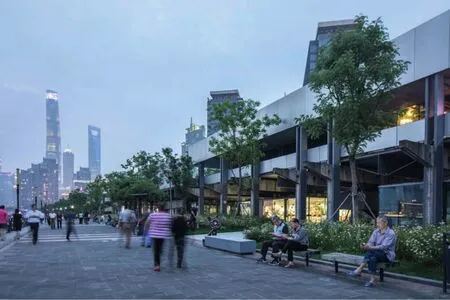
7 滨江的步道/The riverfront walkway

8 悬吊的玻璃盒子作为商业空间/Suspended glass boxes as retail space

9 煤仓下主展厅/The main hall under the coal hoppers
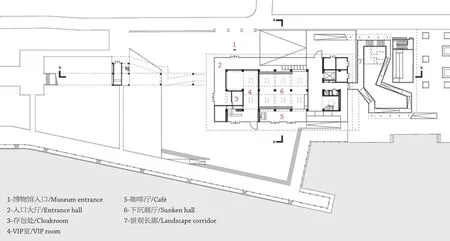
10 首层平面/Ground floor plan

11 剖面/Section
评委评语
克里斯汀·菲莱斯:一个部分损毁、部分保留的煤仓被改造成了一座优雅的美术馆。通过走廊、楼梯和平台,原来的工业环境转变为公共空间,这里有高品质的地景,美丽的江景,令人流连忘返。不同层面的悬臂和壁龛独立于建筑之外,使博物馆成为了无论是对游客还是对非游客而言都非常慷慨的城市环境的馈赠,并且激发了城市活力。(钱芳 译)
Jury Statement
Kristin Feireiss: A partly destroyed, partly maintained coal bunker has elegantly been converted into an art museum. Through walkways, staircases and platforms the transformation of the industry area turns it into a public space with landscape qualities, a beautiful view to the water as well as rich possibilities of staying. The cantilevers and niches on different levels make the museum - independently of the building - a generous contribution to the urban context for visitors and nonvisitors, revitalising the city.

12 高架步道/The elevated walkway

